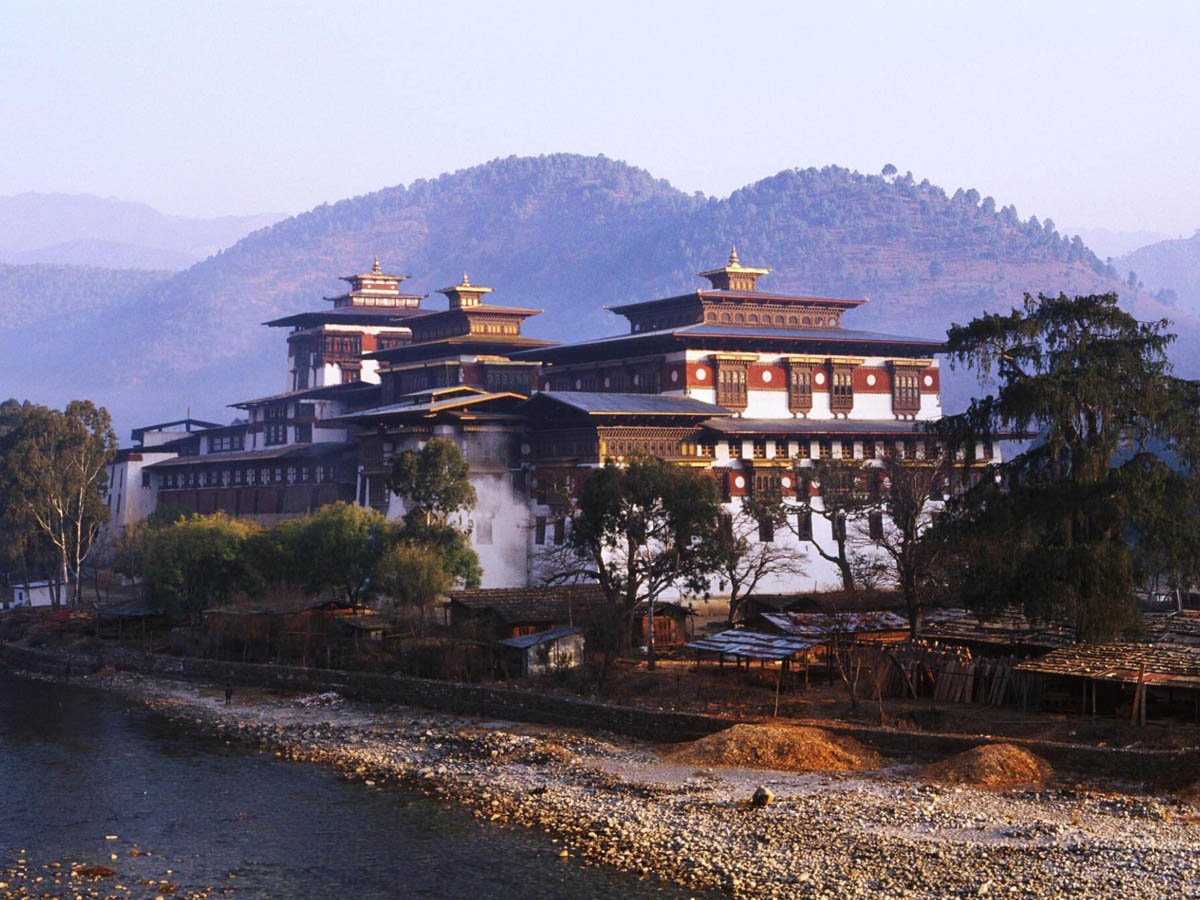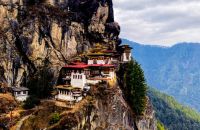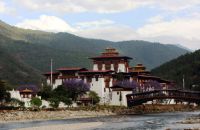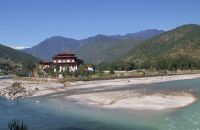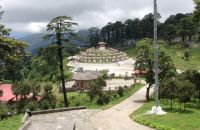Talk with our local travel specialist who can help organize your trip.
All You Need to Know for an Unforgettable Trip to Bhutan in 2024
The untouched kingdom of Bhutan tucked away in the heart of the Eastern Himalayas, is a hidden gem worth exploring. As you plan your adventure to this mystical land in 2024, prepare to be mesmerized by its unique blend of tradition, spirituality, and breathtaking natural landscapes.
In this comprehensive guide, you will find everything you need to know to make your trip to Bhutan unforgettable, from the entry requirements, destinations, cultural etiquette, and practical travel tips.
Visa and Entry Guidelines
Bhutan's distinctive tourism policy requires each tourist to book a government-approved tour operator with a registered guide and a private vehicle. Your tour operator facilitates the visa acquisition process.
All travelers to Bhutan must obtain a Bhutan Visa, except for Indian, Maldivian, and Bangladeshi nationals, who receive an entry permit upon arrival at designated entry points.
For non-exempt nationalities, the following process is followed
Bhutanese visas are secured through licensed Bhutanese tour operators via online processing.
Your chosen tour operator will manage all necessary arrangements and request specific documents, including passport-sized photographs and vital information for the online visa application. Additionally, you'll need valid travel insurance covering the entire trip duration, a copy of your passport (valid for at least six months beyond your planned departure from Bhutan), and your travel itinerary. The tour operator will provide pre-booking details, such as a hotel confirmation voucher in Paro.
The visa application fee is USD 40 and is issued by the Department of Immigration within five working days.
The tour operator will deliver the visa before you enter Bhutan.
Immigration officers will verify it upon arrival at Paro International Airport or at overland entry points at Phuentsholing and Samdrup Jongkhar.
Best Time to Visit
Spring (March, April, May) and autumn (September, October, November) are the best times to visit Bhutan, characterized by pleasant weather and vibrant landscapes. On the other hand, winter (December to February) is known to be cold as Bhutan is situated at higher altitudes, while the monsoon (June to August) may bring heavy rainfall, affecting accessibility.
The best time to travel to Bhutan is during the spring, from April to May when the sunny days bring in pleasant weather and visible flora and fauna. The temperature ranges from 5°C to 29°C, which is best for enjoying outdoor activities under the bright blue skies. During this season, festivities such as Paro Tsechu, Ura Yakchoe, the Rhododendron Festival, Zhemgang Tshechu, and Domkhar Tsechu are joyously observed.
The other good season for visiting Bhutan is autumn, from September to mid-November, when the temperature is 8°C to 28°C. The skies are clear and best for nature excursions. This season hosts numerous festivals featuring cultural events, masked dances, and religious rituals like Wangdue Phodrang Tshechu, Gangtey Tshechu, and the Black-Necked Crane Festival, providing opportunities to experience vibrant traditions and celebrations.
Less favorable times for traveling to Bhutan are during monsoon, in June, July, and August, the temperatures rise, reaching approximately 32°C, accompanied by substantial rainfall. Another off-season occurs in winter when temperatures can drop as low as -5°C, and there is a chance of snowfall in the hills. Nevertheless, if your travel plans involve visiting cities at lower altitudes, such as Paro and Thimphu, for a few days, these off-seasons can still be ideal for budget-friendly travel.
Choosing the Right Tour Package
To make your Bhutan trip unforgettable, you must customize your itinerary as per your interests, whether trekking, cultural experiences or spiritual retreats.
You can opt for a short tour spanning 5 to 7 days or a longer tour spanning 12 to 15 days.
Short tours can be done in the western parts of Bhutan to visit popular cities like Paro, Thimphu, and Punakha, where you can observe destinations like the Tiger's Nest Monastery, Buddha Dordenma, Punakha Dzong.
Longer tours take various routes and offer a comprehensive experience. It can cover Bhutan's western and central regions, including Paro, Thimphu, Punakha, Bumthang, Gangtey, and Trongsa.
You can also opt for short trekking destinations like the 8-day Druk Path trek or a longer one like the 17-day Laya Gasa trek or even the month-long Snowman trek. In addition to the shorter tours, longer tours offer more in-depth experience into the cultures and traditions by exploring remote villages and participating in local religious events and festivals. You'll also experience true natural beauty by walking on unique trails that offer amazing views of hills and the Himalayas of Bhutan. These tours have everything from the Haa Valley tour to the Gangtey trail and Drukgyul hiking.
Bhutan Tour Cost
The tour cost of a Bhutan visit is unique and designed to ensure sustainable tourism through the "High Value, Low Impact Tourism" policy. The budget depends on factors including entry fees, accommodation, mandated fees, transportation fees, the duration of your stay, and the type of services you want. The costs are mentioned below:
Bhutanese Visa Fee
The fee is USD 40 for processing the visa, which the licensed Bhutanese tour operator typically arranges as part of a comprehensive travel package.
SDF (Sustainable Development Fee)
Besides the visa fee, tourists are subjected to a Sustainable Development Fee (SDF) of $100 per night. This has been recently modified, effective from September 2023 to September 2027. The fee supports Bhutan's commitment to environmental conservation and socio-economic development.
Children aged 6 to 12 get a full 50% discount on the SDF, while those aged five or under are completely exempt from the fee. It does not include costs for food, entry fees, accommodation, transportation, and guide fees. Therefore, allocating a separate budget for these aspects of the journey is essential. It is worth noting that while nationals from India, Maldives, or Bangladesh do not require a visa, they must still pay the applicable SDF, ranging from $15 to $17.
Tour Package Cost
The cost of the tour package varies on the duration of the trip, the destinations included your chosen level of accommodation, and the services provided, including transportation and guided services. As a baseline, a day in significant Bhutanese cities like Thimphu and Paro typically ranges from 250 to 300 USD per person, covering the tour operator fee, accommodation, food, and private vehicles, excluding the SDF. Opting for a luxury experience with upscale accommodation and premium transportation can escalate the cost to as much as $2000. Some of these expenses are settled in advance through your agent's pre-booking.
Additional Expenses
Tourists must factor in extra costs for extra meals, activities like entrance fees if they want to visit religious sites, tips, and personal souvenirs. They need to plan for any additional spending.
An average tour to Bhutan is approximately 350 to 400 USD (roughly 550 to 625 AUD) per person daily. This includes all possible expenses and fees.
Reaching Bhutan
Via Air
Paro has the only international airport in the entire Bhutan, so tourists coming to Bhutan via flight need to fly to the nearest gateway in Paro International Airport. Druk Air and Bhutan Airlines operate daily connecting flights from cities such as Delhi, Mumbai, Gaya, Guwahati, Bagdogra, Kolkata (India), Kathmandu (Nepal), Bangkok (Thailand), and Singapore.
Via Road
An alternative route to reach Bhutan is by road, especially if traveling from a neighboring country like India. Alternatively, you may explore the two other entry points in Assam: Bongaigaon-Gelephu and Darangamela-Samdrup border. However, the most commonly used entry point is through Phuentsholing. Once there, you can avail yourself of a regular bus to Thimphu or Paro.
Exploring Bhutan's Wonders
Some of the must-visit places in Bhutan are listed below:
Paro Valley
All international entries are made via Paro, which falls on the route of major Bhutan tour packages.
Kyichu Lhakhang
Built in 659 AD, it stands as one of the oldest and holiest temples, housing the esteemed statue of Jowo Jampa.
Ringpung Dzong
Constructed in the 16th century and situated atop a hill, it is a fortress-monastery renowned for its sacred religious scroll painting, Thongdrol. This painting is exhibited to the public during the Paro festival.
Tiger's Nest Monastery

Locally known as Paro Taktsang, it is Bhutan's most iconic landmark, perched dramatically on a cliffside. It is renowned as the meditative retreat of the revered Guru Rinpoche.
Thimphu
The capital of Bhutan is a historically and politically significant place.
Buddha Dordema is an astounding architectural marvel, soaring over 169 feet as a statue of Shakyamuni Buddha.
Tashichho Dzong
serves as the seat of the Bhutanese government and the monarch's official residence, combining administrative and religious functions within its majestic structure.
Punakha – The Ancient Capital

It is the ancient capital of Bhutan, situated at the confluence of two great rivers
Chimi Lhakhang
known locally as the Temple of the Divine Madman, is a distinctive temple adorned with phallic symbols, renowned for bestowing fertility blessings.
Punakha Dzong
Punakha Dzong, built amidst the Pho Chhu and Mo Chhu rivers in the 17th century, serves as a fortress and a religious center, showcasing intricate architecture and housing important relics.
Bumthang Valley

The valley is best known for preserving religious beliefs and culture and is thus called the religious heartland of Bhutan.
Jambay Lhakhang
Celebrated for its fire ceremony (Mewang) during Jambay LhakhangDrup, which is believed to anchor an ancient ogre, averting potential harm to the community.
Phobjikha Valley
Known for the natural trails and the winter migration of black-necked cranes, Phobjikha is a true winter wonderland.
Gangtey Monastery is renowned for the breathtaking spectacle of the migratory Black Neck Crane festival during specific seasons.
Featured Trips
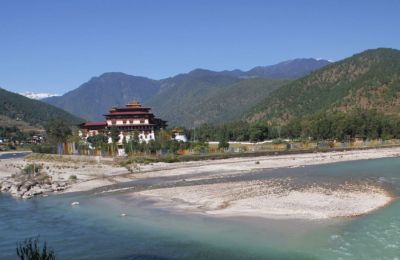
Bhutan Cultural Tour - 5 days
Bhutan Cultural Tour of 5 days lets you discover the rich Bhutanese culture. Visit ancient fortresses and Taktsang Monastery. Enjoy traditional hot stone bath.
Inquire Now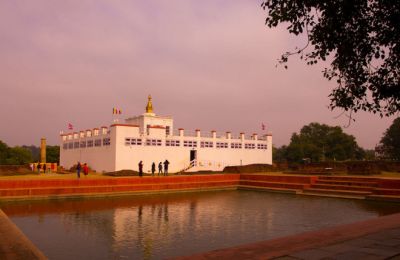
Nepal and Bhutan Buddhist Pilgrimage Tour - 12 days
Bhutan Buddhist Tour from Kathmandu-12 days is a sacred Buddhist Pilgrimage Tour to Nepal and Bhutan. Visit Lumbini, Lord Buddha’s birthplace and Tiger’s Nest.
Inquire NowWhere to travel next?
Get help from our travel specialists for holiday ideas that matches your interests.
Embracing Bhutanese Culture
Dress Code and Cultural Etiquette
Traditional Attire
The national identity and dedication to preserving age-old customs are reflected in the traditional dress, known as "Kira" for women and "Gho" for men. Additionally, monks adhere to Buddhist traditions by wearing long maroon robes.
Religious significance
The locals respect their religious norms. They wear full-length attire, removing shoes and caps in specific religious sites. It is essential to ask permission before capturing photographs, particularly in religious locations.
Environmental Commitment
Bhutan's commitment to sustainability is reflected by the ban on single-use plastics and eco-friendly alternatives.
Local Language
The official language is Dzongkha. Learn the basic greetings such as "Kuzuzangpo la" (hello) and "Kadinche la" (thank you).
Festivals and Events
Bhutan celebrates festivals and events all around the year. You can plan your trip by aligning it with the festivals so that you get to observe the traditional dances, masked performances, and religious ceremonies.
Festivals in Spring
Many festivities are lined up from early March to April 2024, like the three-day Gomkora, where nomadic tribes perform celebratory dances and songs. Festivals like Chhorten Kora, Domkhar Tsechu, and Ura Yakchoe are also celebrated.
Festivals in Spring
Many festivities are lined up from early March to April 2024, like the three-day Gomkora, where nomadic tribes perform celebratory dances and songs. Festivals like Chhorten Kora, Domkhar Tsechu, and Ura Yakchoe are also celebrated.
Festivals in Summer
Bumthang hosts the Nimalung and Kurjey Tsechu celebrations in June, while the Haa Summer festival is celebrated in mid-July.
Festivals in Autumn
The Autumn season features major festivals like Thimphu Tsechu, Jhomolhai Mountain Festival, Thangbi Mani, Jakar Tsechu, Gangtey Tsechu, RoyalHighland Festival and the Black Necked Crane Festival in November.
Festivals in Winter
Winter festivals include Trongsa Tshechu with the sacred Cham Dance, Druk Wangyel Tsechu, Nbji Lhakhang Drup, Samdrupjongkhar Tsechu, andLhuentse Tsechu in December, while February features Punakha Drubchen, PunakhaTsechu, and Tharpaling Thongdrol.
Delightful Bhutanese Cuisine
Bhutan's unique cuisine has ingredients that are grown locally and readily accessible in the Himalayas. Key ingredients are chilies, cheese, potatoes, rice, and buckwheat.
Indulge in the savory goodness of Ema Datshi, a cheese and chili stew, along with delectable dumplings, Shamu Datshi, a spicy mushroom and cheese stew, and Paksha paa, a flavorful spicy pork stew with vegetables. Explore unique and distinctive flavors with dishes like Khur-LeBhutanese pancake, Juma meat and rice sausages wrapped in the intestine, and Goep stir-fried tripe, providing a taste experience you won't find elsewhere.
Known best for simplicity, authenticity, and incorporation of locally sourced ingredients, Bhutanese dishes showcase a remarkable fusion of flavors and spices. This must-try Bhutanese cuisine captures the region's essence, offering a gastronomic journey that beautifully reflects the country's rich cultural tapestry.
Practical Travel Tips
Altitude Sickness
As Bhutan is a Himalayan country, the altitude is generally higher than other South Asian nations. Thimphu, the capital city, is approximately 2,334 meters (7,657 feet) above sea level. Hence, it is essential to acclimatize gradually to the high altitude, especially if you come from low-altitude places.
It is advised to drink water and listen to your body if you experience symptoms like headaches or dizziness.
Transportation
Transportation within Bhutan can be done by air and by road.
Domestic flights operate in Paro, Yonphula, Bumthang, and Gelephu via the national carrier Drukair. However, the flights are less frequent and depend on the weather.
The most popular medium is by road as the country is relatively small. Taxis, private vehicles, minibusses, and public buses always go in and around the cities. Bhutan's traffic is surprisingly uncrowded, with no traffic lights; instead, traffic is managed by policemen. However, opting for a taxi or private vehicle when traveling to your destination is recommended for a quicker journey.
Accommodations
Bhutan offers a wide range of accommodation options, from luxury resorts to cozy guesthouses, depending on the location.
Homestays
These family-run houses offer a glimpse into local life. Expect to pay around $30 - $50 per night for a homestay experience.
Heritage Hotels
Bhutan's architectural heritage, such as dzongs (fortresses) or renovated farmhouses, is converted into charming heritage hotels. Prices range from$100-$250 per night, depending on the location and level of luxury.
Boutique Hotels
They offer a personalized and intimate experience. They provide attentive service and locally-inspired design elements, costing $150 - $300 per night.
Luxury Resorts
They offer stunning views, impeccable service, gourmet dining, and spa treatments. It can range from $300 to $1000 or even more per night.
Currency and Cash
The official currency in Bhutan is the Bhutanese Ngultrum (BTN). In some areas, the Indian Rupees are also accepted. As credit cards are not universally accepted, carrying cash is recommended, especially for small transactions with vendors. Most hotels do accept credit cards, and in the capital city, there are banks and authorized exchange centers available.
Internet
The dominant internet service provider is Bhutan Telecom, owned by the government and offers fixed-line broadband and mobile internet through its Druknet brand. Once you land, you can ask the tour operator to manage a local SIM card with a data plan from Tashi Cell or B-Mobile for mobile internet access. The internet speed depends on the location.
You can use the free Wi-Fi in hotels, though the speed and reliability can vary. Alternatively, the internet cafes are also available in Thimphu and Paro. Public Wi-Fi hotspots are rare, and internet access is mostly concentrated in major cities.
It is worth noting that the government has some download restrictions, and some social sites may be blocked.
Conclusion
As you embark on your journey to Bhutan in 2024, anticipate an unforgettable trip that includes cultural immersion, religious knowledge, and awe-inspiring landscapes.
To book your tour to Bhutan, contact our travel agents, who will plan a customized and adventurous trip for you.
Featured Trips
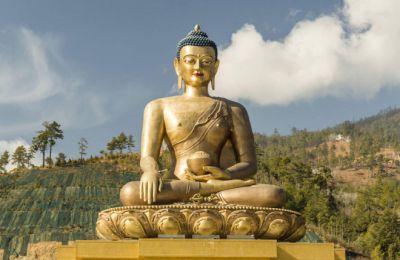
Bhutan Heritage Tour - 8 days
Bhutan Heritage Tour lets you explore centuries-old dzongs and Lakhangs built by Bhutanese kings and spiritual leaders. Take this Bhutan Heritage Tour and journey across the cultural hotspots of Bhutan, a fascinating Himalayan kingdom.
Inquire Now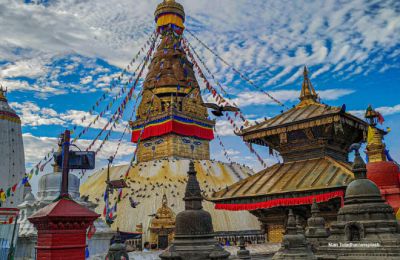
Nepal and Bhutan Classic Tour - 8 days
Nepal and Bhutan Classic Tour of 8 days will take you to Visit two Himalayan countries on a single trip with our Nepal and Bhutan Classic Tour of 8 days. The multi-country tour offers you a chance to explore two dramatic landscape and their rich culture and tradition.
Inquire NowWhere to travel next?
Get help from our travel specialists for holiday ideas that matches your interests.
- Written by: Naba Raj Amgai
Updated: Feb, 19, 2024

